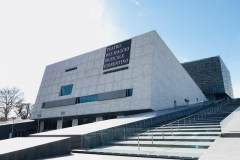The Tales of Hoffmann
Mo | Tu | We | Th | Fr | Sa | Su |
Les contes d’Hoffmann (The Tales of Hoffmann) – Jacques Offenbach | Opera
Total duration: approximately 2 hours and 40 minutes
Fantastic opera in a prologue, three acts, and an epilogue, Les contes d’Hoffmann by Jacques Offenbach was first performed on 10 February 1881 at the Opéra-Comique in Paris. The composer had died a few months earlier and had not been able to complete the score he had worked on extensively over the years. After prolonged negotiations between the director of the Opéra-Comique, Léon Carvalho, and the librettist Jules Barbier, the task of completing the work was entrusted to Ernest Guiraud, a friend of the late composer. Offenbach had composed a large amount of music for the Tales but had not managed to finalize a definitive version. The variability of the content is reflected in the structure of the opera, which is full of temporal jumps, interruptions, and digressions in pure Hoffmannian style.
E.T.A. Hoffmann, a central figure of German Romanticism, is the protagonist of the story, set in various European cities in the early 19th century. While the Prologue and Epilogue take place in Nuremberg at Master Luther’s tavern, where Hoffmann begins to recount his amorous adventures, the intermediate acts are set in Paris, Munich, and Venice, each centered on a female figure: Olympia, Antonia, and Giulietta, the women loved by the writer. A complex and layered opera, full of bizarre situations, diabolical spells, and visions, Les contes d’Hoffmann presents a rich variety of musical atmospheres full of enchantment.
Synopsis
Prologue
A tavern in Nuremberg: The Muse appears and reveals to the audience her purpose is to draw Hoffmann's attention and make him abjure all his other loves, so he can be devoted only to her: poetry. She takes the appearance of Hoffmann's closest friend, Nicklausse. The prima donna Stella, performing Mozart's Don Giovanni, sends a letter to Hoffmann, requesting a meeting in her dressing room after the performance. The letter and the key to the room are intercepted by Councillor Lindorf ("Dans les rôles d'amoureux langoureux" – In the languid lovers' roles), the first of the opera's incarnations of evil, Hoffmann's Nemesis. Lindorf intends to replace Hoffmann at the rendezvous. In the tavern, students wait for Hoffmann. He finally arrives, and entertains them with the legend of Kleinzach, the dwarf ("Il était une fois à la cour d'Eisenach", “Once upon a time at the court of Eisenach”). Lindorf coaxes Hoffmann into telling the audience about his three great loves.
Act 1 (Olympia)
This act is based on a portion of "Der Sandmann".
Parlor of a scientist in Paris: Hoffmann's first love is Olympia, an automaton created by the scientist Spalanzani. Hoffmann has fallen in love with her, not realizing that she is a mechanical doll ("Allons! Courage et confiance...Ah! vivre deux!", “Come on! Courage and trust... Ah! to live together!”). To warn Hoffmann, Nicklausse, possessing the truth about Olympia, sings a story of a mechanical doll with a human appearance, but Hoffmann ignores him ("Une poupée aux yeux d'émail", “A doll with enamel eyes”). Coppélius, Olympia's co-creator and the act's incarnation of Nemesis, sells Hoffmann magic glasses to make Olympia appear as a real woman ("J'ai des yeux", “I have eyes”).
Olympia sings one of the opera's most famous arias, "Les oiseaux dans la charmille" (”The birds in the bower”; often referred to as "The Doll Song"), during which she winds down and needs to be wound up by Spalanzani before she can continue singing. Hoffmann is tricked into believing his affections are returned, to the bemusement of Nicklausse, who subtly attempts to warn his friend ("Voyez-la sous son éventail", “See her under her fan”). While dancing with Olympia, Hoffmann falls to the ground, breaking his magic glasses. At the same time, Coppélius bursts in, tearing Olympia apart in revenge against Spalanzani who had cheated him of his fees. With the crowd ridiculing him, Hoffmann realizes he had loved an automaton.
Act 2 (Antonia)
This act is based on "Rath Krespel".
Crespel's house in Munich: After a long search, Hoffmann finds the house where Crespel and his daughter Antonia are hiding. Hoffmann and Antonia loved each other, but were separated after Crespel decided to hide his daughter from Hoffmann. Antonia inherited her mother's talent for singing, but her father forbids her to sing because of her mysterious illness. Antonia wishes her lover would return to her ("Elle a fui, la tourterelle", "She fled, the dove"). Her father also forbids her to see Hoffmann, who encourages Antonia in her musical career, and therefore endangers her without knowing it. Crespel tells Frantz, his servant, to stay with his daughter, and after Crespel leaves, Frantz sings a comical song about his talents ("Jour et nuit je me mets en quatre", "Day and night, I quarter my mind”).
After Crespel leaves his house, Hoffmann takes advantage of the occasion to sneak in, and the lovers are reunited (a love duet: "C'est une chanson d'amour", "It's a love song"). After Crespel returns, he receives a visit from Dr. Miracle, the act's Nemesis, forcing Crespel to let him heal her. Eavesdropping, Hoffmann learns Antonia may die if she sings too much. He returns to her boudoir and makes her promise to give up her artistic dreams. Antonia reluctantly accepts her lover's will. After she is alone, Dr. Miracle enters Antonia's boudoir to persuade her to sing and follow her mother's path to glory, stating Hoffmann is sacrificing her to his brutishness, and loves her only for her beauty. With mystic powers, he raises a vision of Antonia's dead mother and induces Antonia to sing, causing her death. Crespel arrives just in time to witness his daughter's last breath. Hoffmann enters, and Crespel wants to kill him, thinking he is responsible for his daughter's death. Nicklausse saves his friend from the old man's vengeance.
Act 3 (Giulietta)
This act is loosely based on Die Abenteuer der Silvester-Nacht (A New Year's Eve Adventure).
A gallery in a Venetian palace: The act opens with the barcarolle "Belle nuit, ô nuit d'amour" ("Beautiful night, oh night of love"). Hoffmann falls in love with the courtesan Giulietta and thinks she returns his affections ("Amis, l'amour tendre et rêveur", "Friends, tender and dreamy love"). Giulietta is not in love with Hoffmann, but seducing him under the orders of Captain Dapertutto, who promises her a diamond if she steals Hoffmann's reflection from a mirror ("Scintille, diamant", "Sparkle, diamond"). The jealous Schlemil (see Peter Schlemihl for a literary antecedent), a previous victim of Giulietta and Dapertutto (he gave Giulietta his shadow), challenges the poet to a duel but is killed thanks to the magic sword Hoffmann was given by Dapertutto. Nicklausse wants to take Hoffmann away from Venice and looks for horses. Meanwhile, Hoffmann meets Giulietta and cannot resist her ("O Dieu! de quelle ivresse", "O God! of what intoxication"): he gives her his reflection, only to be abandoned by the courtesan, to Dapertutto's great pleasure.
In the original version, Hoffmann, furious at being betrayed, tries to stab Giulietta but — blinded by Dapertutto — mistakenly kills his dwarf, Pittichinaccio. In Richard Bonynge's version, Giulietta is poisoned and dies by accidentally drinking the philter Dapertutto prepared for Nicklausse.
Epilogue
The tavern in Nuremberg: Hoffmann, drunk, swears he will never love again, and explains that Olympia, Antonia, and Giulietta are three facets of the same person, Stella. They represent the young girl's, the musician's, and the courtesan's side of the prima donna, respectively. After Hoffmann says he does not want to love any more, Nicklausse reveals she is the Muse and reclaims Hoffmann: "Be reborn a poet! I love you, Hoffmann! Be mine" ("Renaîtra un poète! Je t'aime, Hoffmann! Sois à moi!"). The magical poetry reaches Hoffmann and he sings "O Dieu! de quelle ivresse ("O God! of what intoxication") once more, ending with "Muse, whom I love, I am yours" ("Muse que j'aime, je suis à toi!"). At this moment, Stella, tired of waiting for Hoffmann to come to her rendezvous, enters the tavern and finds him drunk. The poet tells her to leave ("Farewell, I will not follow you, phantom, the spectre of the past", "Adieu, je ne vais pas vous suivre, fantôme, spectre du passé"), and Lindorf, waiting in the shadows, comes forth. Nicklausse explains to Stella that Hoffmann does not love her anymore, but Councillor Lindorf is waiting for her. Some students enter the room for more drinking while Stella and Lindorf leave together.
Program and cast
Maestro concertatore and conductor: Kent Nagano
Chorus Master: Lorenzo Fratini
Direction and costumes: Laurent Pelly
Sets: Chantal Thomas
Lighting: Joël Adam
Video: Charles Carcopino
Orchestra and Chorus of the Maggio Musicale Fiorentino
Stella/Olympia/Antonia/Giulietta – Jessica Pratt
La Muse/Nicklausse – Marvic Monréal
Hoffmann – Dmitry Korchak
Lindorf/Coppelius/Dr. Miracle/Dapertutto – Alex Esposito
Crespel/Luther – Martin Summer
Andrès/Cochenille/Frantz/Pitichinaccio – Didier Pieri
Production of the Deutsche Oper Berlin
Cast updated as of 30 June 2025
Teatro del Maggio Florence State Opera Italy
Teatro del Maggio is in the centre, close to the old city walls, next to the historic Stazione Leopolda. The garden that welcomes visitors is Piazzale Vittorio Gui, named after the founder of the Stabile Orchestrale Fiorentina and the Maggio Musicale Fiorentino.
By train
Santa Maria Novella is Florence's main train station.
From there you can reach the theatre with a short walk (about 10-15 minutes) or by taking the tram (a stop) or a taxi.
By car
The Opera di Firenze is just outside the ZTL area.
It is possible to park near the Parco delle Cascine or for a fee in the Porta al Prato car park (Via Elio Gabbuggiani, 7) and in the Piazza Vittorio Veneto car park.
By bus
Lines C1, C2 and D (Leopolda stop);
Lines 17 and 23A-B (stop Via delle Carra);
Lines 17B-C, 22, 23N, 23 and 57 (Pierluigi da Palestrina stop);
Lines 29, 29B, 29BA, 29BC, 29D, 30A, 30B, 30AC, 35 and 35° (stop Leopolda - Porta al Prato; Capolinea).
By tram
Line T1 (stop Porta al Prato - Parco della musica).

 EN
EN DE
DE IT
IT FR
FR ES
ES RU
RU JP
JP RO
RO
 Seating plan
Seating plan 